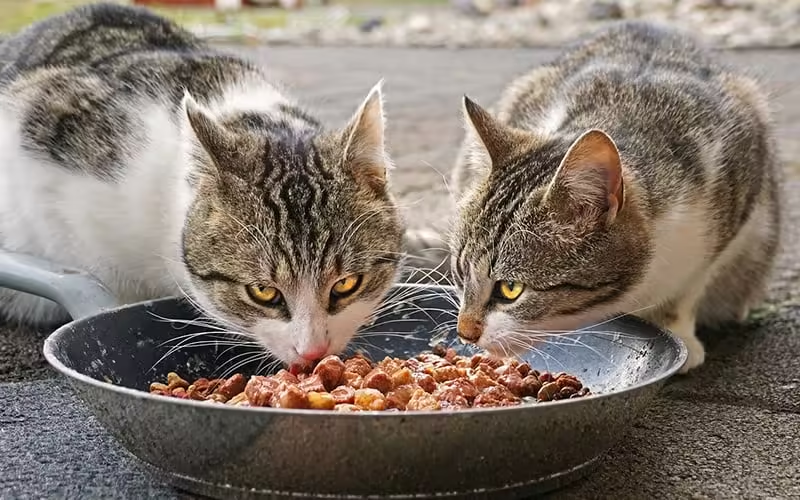Cats are beloved companions, known for their curious nature and playful personalities. However, their curiosity can sometimes lead them to explore foods that are harmful or even toxic. As a responsible cat owner, it’s crucial to know what foods to avoid to keep your feline friend safe and healthy. This detailed guide will cover everything you need to know about what can cats not eat, including common toxic foods, harmful substances, plants to avoid, signs of poisoning, and what to do if your cat ingests something dangerous.

Table of Contents
- Introduction
- Common Foods Toxic to Cats
- 2.1 Chocolate
- 2.2 Onions and Garlic
- 2.3 Grapes and Raisins
- 2.4 Alcohol
- 2.5 Caffeine
- 2.6 Xylitol
- Other Harmful Foods
- 3.1 Raw Fish
- 3.2 Dairy Products
- 3.3 Bones
- 3.4 Certain Nuts
- Plants That Are Toxic to Cats
- Signs of Poisoning in Cats
- What to Do if Your Cat Eats Something Toxic
- Preventative Measures
- Conclusion
- Resources
1. Introduction to What can Cats Not Eat
Cats are obligate carnivores, meaning their bodies are designed to thrive on a diet primarily composed of meat. While they may occasionally nibble on plant material, their nutritional needs are best met with high-quality animal proteins. However, as curious creatures, cats often find themselves exploring the human food world, sometimes leading to accidental ingestion of harmful substances. Did you know you can check your Cat’s Age in Human years using our Cat Age Calculator.
This article aims to provide a thorough understanding of what cats cannot eat, ensuring that you can create a safe environment for your furry friend.
2. Common Foods Toxic to Cats
2.1 Chocolate
Chocolate is a well-known toxin for pets, particularly dogs, but it can also be dangerous for cats. The compounds in chocolate, primarily theobromine and caffeine, can affect a cat’s central nervous system and cardiovascular system. The darker the chocolate, the more toxic it is; for instance, dark chocolate and baking chocolate contain higher levels of theobromine compared to milk chocolate.
Symptoms of Chocolate Poisoning
- Vomiting
- Diarrhea
- Increased heart rate
- Restlessness
- Muscle tremors
- Seizures
If you suspect your cat has eaten chocolate, contact your veterinarian immediately for guidance. Anything which triggers these above symptoms may be in the list of What can Cats Not Eat.
2.2 Onions and Garlic
Onions and garlic, both members of the allium family, are particularly toxic to cats. They can cause oxidative damage to red blood cells, leading to hemolytic anemia, which is a serious condition that can be life-threatening. It’s important to know what diet suits your pet hence do check Science Diet Feed for Pets.
Forms to Watch For
Onions and garlic can be found in various forms, including:
- Raw or cooked onions/garlic
- Onion or garlic powder
- Baby food containing onion or garlic
- Certain sauces and seasonings
Symptoms of Onion and Garlic Poisoning
- Weakness
- Lethargy
- Vomiting
- Diarrhea
- Abdominal pain
- Pale gums
It’s vital to keep all forms of onions and garlic out of your cat’s reach and is one of the most common thing that What can Cats Not Eat.
2.3 Grapes and Raisins

Grapes and raisins are often considered healthy snacks for humans, but they can be extremely toxic to cats. While the exact mechanism of toxicity is not well understood, these fruits have been linked to acute kidney failure in cats. You can now easily diagnose your cat’s health by Cat Vomit Color Chart.
Symptoms of Grape and Raisin Poisoning
- Vomiting
- Diarrhea
- Lethargy
- Decreased appetite
- Abdominal pain
- Increased thirst and urination
Even a small amount can lead to serious health issues, so it’s best to avoid giving grapes or raisins to your cat entirely. Hence it is of topmost important in the list of What can Cats Not Eat.
2.4 Alcohol
Alcohol is not only harmful to humans but can also be fatal to cats. Cats are much smaller than humans, and even a tiny amount of alcohol can cause significant harm. Ethanol, the active ingredient in alcohol, affects the central nervous system and can lead to life-threatening conditions. Do you know about the most popular Ragdoll Cat Breed.
Symptoms of Alcohol Poisoning
- Vomiting
- Disorientation
- Difficulty breathing
- Seizures
- Hypoglycemia (low blood sugar)
- Coma
If your cat accidentally ingests alcohol, seek veterinary care immediately.
2.5 Caffeine
Caffeine is another substance that poses serious risks to cats. Found in coffee, tea, energy drinks, and some medications, caffeine can lead to symptoms similar to those of chocolate poisoning.
Symptoms of Caffeine Poisoning
- Restlessness
- Rapid breathing
- Heart palpitations
- Tremors
- Seizures
- Vomiting
Always keep caffeinated products out of reach of your cat.
2.6 Xylitol
Xylitol is a sugar substitute commonly found in sugar-free gum, candies, and some baked goods. While it’s safe for humans, it can cause a rapid release of insulin in cats, leading to hypoglycemia.
Symptoms of Xylitol Poisoning
- Vomiting
- Loss of coordination
- Seizures
- Liver failure in severe cases
If you suspect your cat has ingested xylitol, contact your veterinarian for assistance.
3. Other Harmful Foods
3.1 Raw Fish
Cats may enjoy the smell and taste of fish, but raw fish can be risky. It can harbor harmful bacteria and parasites that can cause gastrointestinal issues. Additionally, certain types of fish contain thiaminase, an enzyme that breaks down thiamine (vitamin B1), leading to serious neurological issues in cats.
Symptoms of Raw Fish Poisoning
- Vomiting
- Diarrhea
- Lethargy
- Loss of appetite
Cooking fish can help eliminate these risks, but it should still be offered in moderation.
3.2 Dairy Products
Many people believe that all cats love milk, but the truth is that most adult cats are lactose intolerant. Lactose, the sugar found in milk, can lead to digestive upset, including diarrhea and vomiting.
Alternative Treats
If you want to treat your cat with a dairy-like flavor, consider lactose-free milk specifically designed for cats, which is available at pet stores.
3.3 Bones
While cats may enjoy chewing on bones, cooked bones can splinter and pose choking hazards or cause serious internal injuries. Raw bones may be safer, but they should still be given with caution and supervision.
Risks of Bones
- Choking hazards
- Internal punctures
- Gastrointestinal obstruction
It’s best to consult your veterinarian before introducing bones into your cat’s diet.
3.4 Certain Nuts
Some nuts, particularly macadamia nuts, are toxic to cats. Symptoms may include weakness, tremors, and vomiting. Other nuts like walnuts and pecans can also pose risks, primarily due to high-fat content, which can lead to gastrointestinal upset. It is an important part of What can Cats Not Eat.
Nut Alternatives
If you want to give your cat a crunchy treat, consider cat-safe snacks specifically formulated for felines.
4. Plants That Are Toxic to Cats
Many household and garden plants can be toxic to cats. Here are some common ones to avoid:
- Lilies: Highly toxic to cats; even small amounts can cause kidney failure.
- Poinsettias: Mildly toxic, can cause irritation and upset stomach.
- Sago Palm: All parts are toxic, particularly the seeds, leading to liver failure.
- Oleander: Can cause severe cardiac issues.
For a more comprehensive list of toxic plants, check the ASPCA’s list of toxic and non-toxic plants.
5. Signs of Poisoning in Cats
Recognizing the signs of poisoning in cats is crucial for prompt treatment. Symptoms may vary depending on the toxin but can include:
- Vomiting
- Diarrhea
- Lethargy
- Excessive drooling
- Difficulty breathing
- Seizures
- Loss of coordination
- Abdominal pain
- Changes in appetite or behavior
If you notice any of these symptoms, seek veterinary assistance immediately.
6. What to Do if Your Cat Eats Something Toxic
If you suspect your cat has ingested a toxic substance, follow these steps:
- Stay Calm: Your reaction can influence your cat’s behavior.
- Identify the Substance: If possible, determine what your cat has eaten. The more information you have, the better your veterinarian can help.
- Contact Your Veterinarian: Provide as much detail as possible, including the substance, quantity, and time of ingestion.
- Follow Instructions: Your vet may instruct you to bring your cat in for treatment or monitor symptoms at home.
In some cases, you may need to induce vomiting, but do not do this without consulting your veterinarian first, as it can sometimes cause more harm than good. This article is exclusively made for pet owners to have a detailed idea regarding What can Cats Not Eat.
7. Preventative Measures
Preventing poisoning starts with education and vigilance. Here are some tips to keep your cat safe:
- Secure Food Storage: Keep all human foods, especially toxic ones, out of reach. Consider using childproof locks on cabinets if necessary.
- Educate Your Family: Ensure that everyone in your household knows which foods are toxic to cats.
- Choose Cat-Safe Plants: When decorating your home or garden, choose plants that are safe for cats.
- Regular Vet Visits: Routine check-ups can help catch potential health issues before they become serious.
- Provide Safe Alternatives: Offer cat-safe treats and toys to satisfy your cat’s curiosity and chewing instincts.
8. Conclusion What can Cats Not Eat
Understanding what cats cannot eat is essential for any cat owner. Many common foods can pose serious health risks, from chocolate and onions to grapes and alcohol. By being vigilant and educated, you can prevent accidental poisoning and ensure your feline friend lives a long, healthy life.
Always remember that when in doubt, it’s better to err on the side of caution. Consult your veterinarian if you are unsure about any food item, and keep the contact information for your local emergency veterinary clinic handy.
For further reading, check out these resources:
By keeping your home safe and understanding the risks, you can enjoy a happy, healthy relationship with your cat.

1 thought on “What can Cats Not Eat”